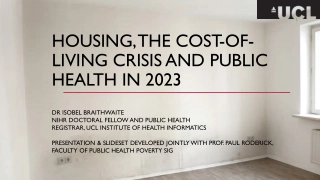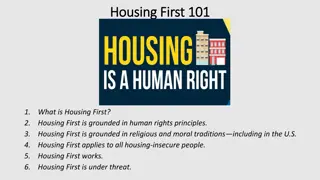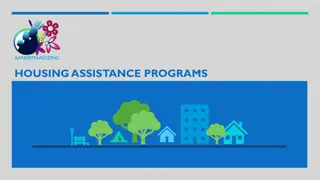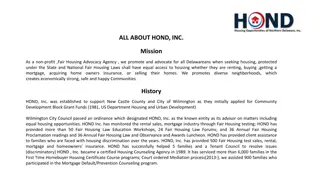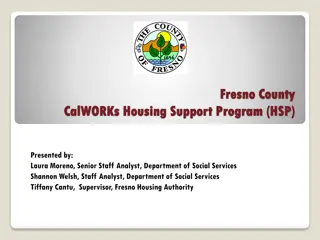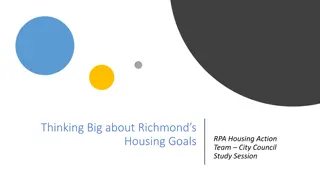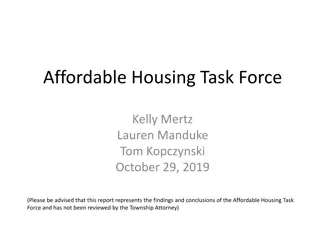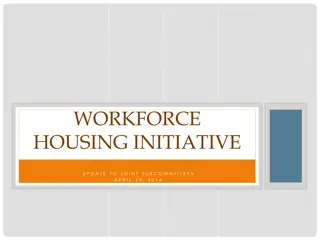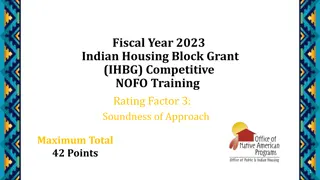Overview of Different Types of Housing Structures
Housing is never isolated but part of a larger environment. It comes in various forms, from attached houses like townhomes and condos to detached homes that stand alone. You'll also find semi-detached houses and terraced homes in different cities. Housing structures vary from pucca houses made of sturdy materials to katcha houses built with wood and mud. Bungalows, ranging from one-story cottages to larger residences, offer a diverse range of living options.
Download Presentation

Please find below an Image/Link to download the presentation.
The content on the website is provided AS IS for your information and personal use only. It may not be sold, licensed, or shared on other websites without obtaining consent from the author.If you encounter any issues during the download, it is possible that the publisher has removed the file from their server.
You are allowed to download the files provided on this website for personal or commercial use, subject to the condition that they are used lawfully. All files are the property of their respective owners.
The content on the website is provided AS IS for your information and personal use only. It may not be sold, licensed, or shared on other websites without obtaining consent from the author.
E N D
Presentation Transcript
LECTURE # 02 LECTURE # 02 TYPES OF HOUSING TYPES OF HOUSING
TYPES OF HOUSING Housing can never be seen in isolation. It is always part of a larger ensemble: a settlement, a city and the built environment. Considered as an object, a house is always in relationship with other elements: houses and buildings, the surrounding spaces and the landscape. In order to address housing cannot lose sight of the fact that a house is always part of a greater assemblage of interrelated elements. Houses can be built in a large variety of configurations. It protects us from many things like sun, rain, wind and enemies. A basic division is between free-standing or Single-family houses and various types of attached or multi-user dwellings. Both may vary greatly in scale and amount of accommodation provided. planning and design, we
TYPES OF HOUSING Attached House An attached house is a structure which shares a common wall or walls with another unit. Some examples of attached dwellings are; townhomes, condominiums, rowhouses, apartment buildings and high-rise residential towers. Detached House A detached house is a stand-alone residential structure that does not share outside walls with another house or building. Also called a separate house or a single-detached dwelling, a detached house is typically the most desirable single-family unit. A single- family detached home, also dwelling, single-family residence (SFR) or separate house is a free-standing residential building. It is defined in opposition to a multi-family residential dwelling. called a single-detached
TYPES OF HOUSING Semi-detached House Asemi-detached house (often abbreviated to semi or semi-D) is a single family dwelling house built as one of a pair that share one common wall. Often, each house's layout is a mirror image of the other. Semi-detached houses are the most common property type in the UK. Terraced House Terraced houses, also referred to as row housing or townhomes, are more common in old industrial towns and cities. A long row of houses, often narrow, attached units with a common wall. Terraced houses are structurally built the same and both sides of each house shares walls with neighbours. It is generally cheaper than detached and semi-detached properties.
TYPES OF HOUSING Pucca House Pucca houses are strong houses. They are made up of wood, bricks, cement, iron rods and steel. Flats and bungalows are pucca houses. Such houses are called permanent houses. Katcha House Katcha houses are made up of wood, mud, straw and dry leaves. A hut is a katcha house. Some people live at one place for a very short time. They build houses that can be moved from one place to another. Such houses are called temporary houses. Bungalow A bungalow is classically defined as a one-story house, cottage, or cabin. However, larger bungalows have been constructed and many small bungalows have been remodeled. Bungalows don t have basements, and they were originally designed to provide affordable housing to the working class.
TYPES OF HOUSING Flat A flat is a type of home that is contained within a larger building. A flat can occupy a whole floor of a building, or only a part of the floor, where different units are separated by walls. The buildings that house flats are usually made for residential purposes only. Duplex A duplex refers to a two-fold apartment or condominium where there are separate entrances for the dwelling units. Usually a duplex comes in the form of a two story house where a common wall separates the two areas. The term duplex can then be extended to make three units or more, and it will then be termed as a three-plex, four-plex, five-plex and so on.
TYPES OF HOUSING Villa The term villa was once used to refer to the upper class country homes of ancient Romans. Today, the term villa has evolved to refer to the beautiful and tasteful country homes of the upper class. Properties that are described as villas generally refer to larger homes with landscaped gardens and perhaps a view of the sea or the countryside. Mansion The word mansion is used to describe a very large house. Traditionally, mansions are characterized by having a large ballroom and numerous bedrooms. Today, however, there is no particular requirement as to what makes a mansion, aside from the fact that it should be a large and well endowed home.
TYPES OF HOUSING Town A housing type, repeated throughout different generations, gives rise to a town structure. The repetition is not just duplication, because it also conveys an adaptation to changing needs. It can be defined as a built-up area with a name, defined boundaries, and local government, which is larger than a village and generally smaller than a city. Towns are further divided into the following types: Company Town Market Town Railway Town
TYPES OF HOUSING Company Town A town is a place where practically all stores and housing are owned by the one company that is also the main employer. Company towns are planned with a suite of amenities such as stores, churches, schools, markets and recreation facilities. Market town Market town or market right is a legal term, originating in the Middle Ages, for a European settlement that has the right to host markets, distinguishing it from a village and city. A town may be correctly described as a "market town" or as having "market rights", even if it no longer holds a market, provided the legal right to do so still exist. Railway Town A settlement that originated or was greatly developed because of a railway station or junction at its site, also known as railroad town.
TYPES OF HOUSING Neighborhood The term neighborhood can be defined as an area or district -- designates a part of the city that can be defined by its physical geography, history, housing and architectural aspect or by its residential, industrial, commercial and administrative functions. In the latter sense, the notion of neighborhood means the place where people live. According to the individuals, and according to their daily spatial practices and their social relationships, the neighborhood can have vague, variable outlines. It can also be defined as an entity that is spatially and socially more limited than a city, which shows a collective unity of life; a place of relationships and specific social proximity; or a space of life defined by the behavior of the inhabitants. practices, connected by
TYPES OF HOUSING Community A community is commonly considered a small or large social unit (a group of people) who has something in common, such as norms, religion, values, or identity. Often communities share a sense of place that is situated in a given geographical area (e.g. a country, village, town, or neighborhood). Durable relations that extend beyond immediate genealogical ties also define a sense of community. People tend to define those social ties as important to their identity, practice, and roles in social institutions like family, home, work, government, society, or humanity, at large. Types of community includes urban, rural, sub-urban, gated and intentional communities.
Rural Community TYPES OF HOUSING Acommunity is called rural if it is located in the country with less than 2,500 people farms and homes are far apart the majority of people depend on agriculture Transportation carries small groups of people such as cars, trucks, tractors, etc. Urban Community Acommunity is called urban if it is located in a large town or city having more than 2,500 people homes and apartments are close together the majority of people depend on industry and business Transportation carries large groups of people subways, buses, etc.
Suburban Community TYPES OF HOUSING A community is called suburban if it is located near the outskirts of a large town or city homes are close together the majority of people depend the work in the cities People living in suburbs work in the city and have transportation to get to work.
TYPES OF HOUSING Gated Communities Gated communities comprise physical areas that are fenced or walled off from their surroundings. The entrances to these areas are usually prohibited or controlled by means of gates or similar physical obstacles. Gated communities are by nature separate and enclosed areas, being isolated from the broader urban environment and enclosed through physical barriers. Besides the main purpose, which enables a specific lifestyle of a group within the enclosed area or to protect the residents from communities reflect an urban entity that is physically -- often socially and economically -- differentiated from the surrounding urban environment. Gated communities are categorized into three types: lifestyle communities, elite communities and security zone communities. possible intruders, gated
TYPES OF HOUSING Intentional Community An intentional community designed from the start to have a high degree of social cohesion and teamwork. The members of an intentional community typically hold a common social, political, religious, or spiritual vision and often follow an alternative lifestyle. responsibilities and resources. The purposes of intentional communities vary in different communities. They may include sharing resources, creating family-oriented neighborhoods, and living ecologically sustainable lifestyles. community is a planned residential They typically share
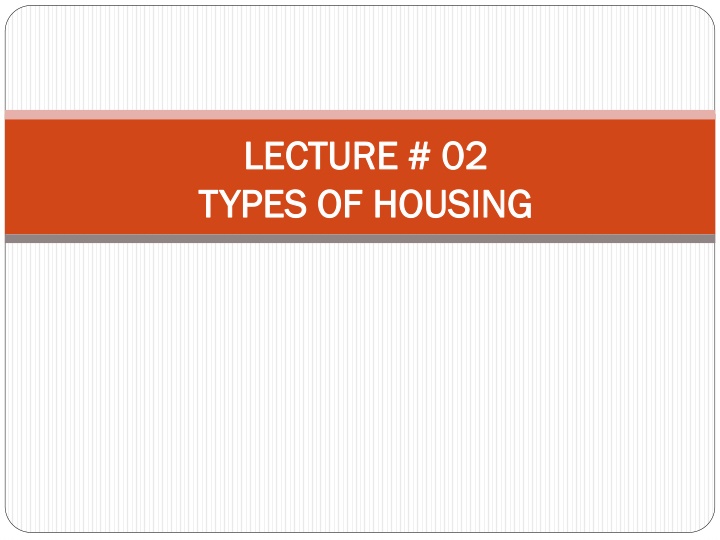
 undefined
undefined








